Transcend SSD320 & SSD720 (256GB) Review
by Kristian Vättö on January 25, 2013 11:31 AM ESTRandom Read/Write Speed
The four corners of SSD performance are as follows: random read, random write, sequential read and sequential write speed. Random accesses are generally small in size, while sequential accesses tend to be larger and thus we have the four Iometer tests we use in all of our reviews.
Our first test writes 4KB in a completely random pattern over an 8GB space of the drive to simulate the sort of random access that you'd see on an OS drive (even this is more stressful than a normal desktop user would see). I perform three concurrent IOs and run the test for 3 minutes. The results reported are in average MB/s over the entire time. We use both standard pseudo randomly generated data for each write as well as fully random data to show you both the maximum and minimum performance offered by SandForce based drives in these tests. The average performance of SF drives will likely be somewhere in between the two values for each drive you see in the graphs. For an understanding of why this matters, read our original SandForce article.

Random read performance is typical SandForce. The SSD320 comes in slightly slower, but the difference is a mere 3.9MB/s compared to SSD720.

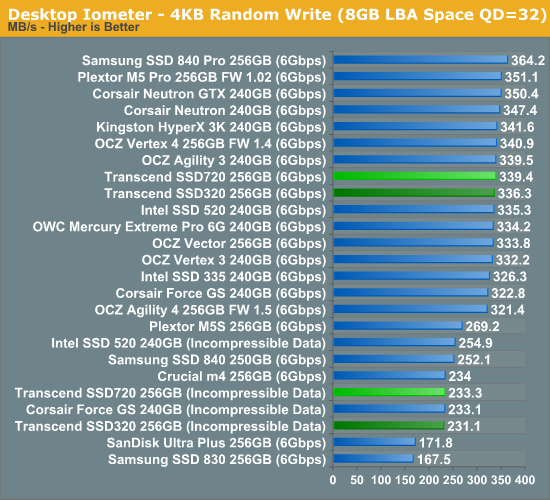
Same story with random write speed; the SSD720 performs hand in hand with Corsair's Force GS (except in QD32 test with compressible data, but Corsair had some issues with that particular aspect), though this is hardly a surprise given that they use identical NAND and the same stock firmware from SandForce. Due to SandForce's real-time compression, the slower NAND in SSD320 only shows up when the data is fed with incompressible data -- with compressible data the SF-2281 writes so little to the NAND that something else becomes a bottleneck even with asynchronous NAND.
Sequential Read/Write Speed
To measure sequential performance I ran a 1 minute long 128KB sequential test over the entire span of the drive at a queue depth of 1. The results reported are in average MB/s over the entire test length.
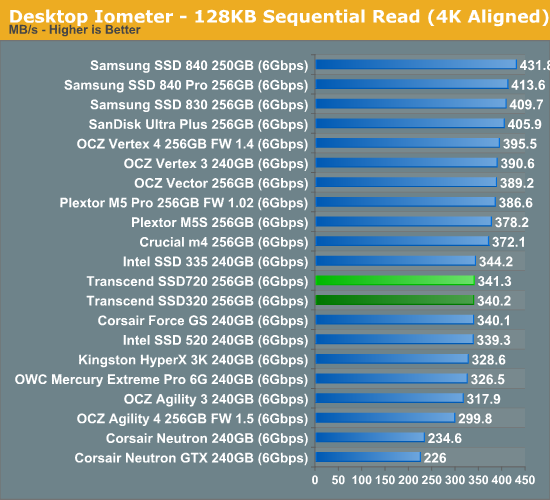
Moving to sequential tests, the SSD720 offers marginally faster write performance than the SSD720.
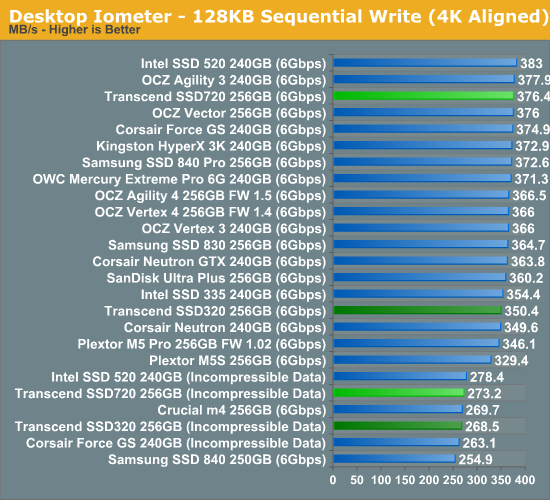
AS-SSD Incompressible Sequential Performance
The AS-SSD sequential benchmark uses incompressible data for all of its transfers. The result is a pretty big reduction in sequential write speed on SandForce based controllers.
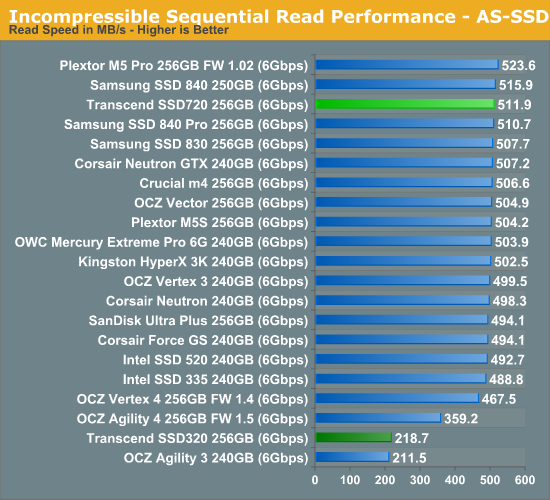
Asynchronous NAND has an enormous impact on incompressible sequential read speed as you can see above. The SSD320 and OCZ's Agility 3, another async NAND based SandForce SSD, perform poorly in this test. It's not a bug or error in our testing as I checked the product specs for the SSD320 and they specified that the maximum read speed for AS-SSD is 220MB/s. When using slower NAND, the performance will be handicapped in scenarios where the NAND is the bottleneck. In this case, the controller and SATA 6Gbps bus are capable of faster throughput but the NAND can't keep up. I believe SandForce's compression adds some overhead as well because the data has to be decompressed -- the Agility 4 with no compression is faster even though it's using async NAND as well.
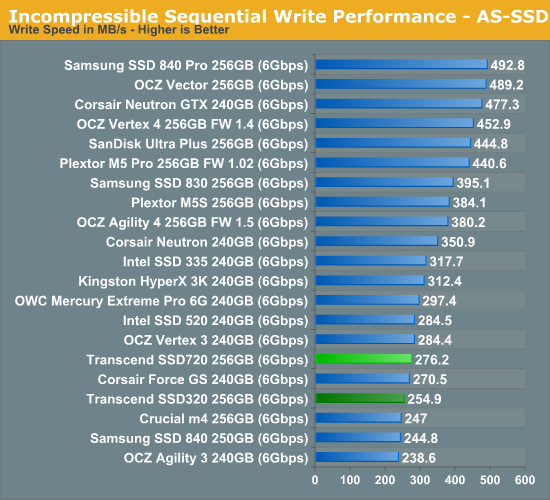










34 Comments
View All Comments
Slash3 - Saturday, January 26, 2013 - link
I picked up one of these (128GB SSD320) when they were about half of the stated market price ($75) during a holiday sale, to put in my Lenovo X230 subcompact laptop. Works great in that capacity, is leaps and bounds above the performance of the stock HDD and adds a margin of shockproofing to a laptop that sees a lot of travel time. At higher prices, it's not as clear cut. If they manage to keep the prices competitive, it's not a bad alternative for a system that needs a basic SSD.Kristian Vättö - Saturday, January 26, 2013 - link
Yup, the regular SSD 840, not the Pro.dj christian - Friday, February 1, 2013 - link
Why not the Pro version?Scour - Saturday, February 16, 2013 - link
Because the Pro is much more expensive?killerbunnies - Saturday, January 26, 2013 - link
Where is the consistency performance for the last two SSD articles?And when can we expect the Intel 520 series 240GB SSD to be included in those graphs?
Kristian Vättö - Saturday, January 26, 2013 - link
There is no point in testing performance consistency with every model. We've tested performance consistency with Intel SSD 335 before, which tells us how SandForce based drives perform. There are no dramatic differences between SandForce based drives, hence we only test consistency when dealing with more unique SSDs.http://www.anandtech.com/show/6428/corsair-neutron...
Nickel020 - Saturday, January 26, 2013 - link
I would have thought that the lower spare area would have an impact on performance consistency. Do you not think that will be the case or is the capacity set apart for RAISE not usable as spare area?Kristian Vättö - Sunday, January 27, 2013 - link
Here are a few graphs of Intel SSD 335 with 25% OP:https://dl.dropbox.com/u/7934241/25%25%20OP_1.png
https://dl.dropbox.com/u/7934241/25%25%20OP_1.png
https://dl.dropbox.com/u/7934241/25%25%20OP%20non-...
Nickel020 - Sunday, January 27, 2013 - link
Thnaks, but I don't quite get it. 25% OP is more than usual, so performance should be more consistent at best, or the same at the worst. The Transcends have less OP though, and I was wondering how you think that would affect consistency?Kristian Vättö - Sunday, January 27, 2013 - link
Oh, sorry, misunderstood your post (I thought you were asking for how more OP would affect the IO consistency on a SandForce drive).Anyway, Transcend only has RAISE disabled - the actual space for OP is the same ~7%. RAISE should not impact consistency because it's just parity data (i.e. the blocks are not empty). However, I haven't tested this so I can't say for sure. Will definitely test, though, didn't even think about it from this angle.